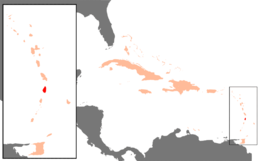Geography of Saint Lucia
| Nickname: Helen of the West Indies | |
|---|---|

Map of Saint Lucia
|
|
| Geography | |
| Location | Caribbean Sea |
| Coordinates | 13°53′N 60°58′W / 13.883°N 60.967°W |
| Archipelago | Windward Islands |
| Area | 616 km2 (238 sq mi) |
| Coastline | 158 km (98.2 mi) |
| Highest elevation | 950 m (3,120 ft) |
| Highest point | Mount Gimie |
| Administration | |
|
Saint Lucia
|
|
| Largest settlement | Castries (pop. 10,634) |
| Demographics | |
| Population | 160,765 (2005) |
| Pop. density | 260.98 /km2 (675.94 /sq mi) |
| Ethnic groups | African 82.5%, Mulatto 11.9%, East Indian 2.4%, White 1.0%, Other or unspecified 3.1% |
Saint Lucia is one of many small land masses composing the insular group known as the Windward Islands. Unlike large limestone areas such as Florida, Cuba, and the Yucatan Peninsula, or the Bahamas, which is a small island group composed of coral and sand, St. Lucia is a typical Windward Island formation of volcanic rock that came into existence long after much of the region had already been formed.
St. Lucia's physical features are notable. Dominated by high peaks and rain forests in the interior, the 616-square-kilometer (238-square-mile) island is known for the twin peaks of Gros Piton and Petit Piton on the southwestern coast, its soft sandy beaches, and its magnificent natural harbors. Mount Gimie, the highest peak, is located in the central mountain range and rises to 958 meters (3,143 ft) above sea level, a contrast that is also evident in the abrupt climatic transition from coastal to inland areas. The steep terrain also accentuates the many rivers that flow from central St. Lucia to the Caribbean. Fertile land holdings, which support banana farming, are scattered throughout the island.
St. Lucia has a tropical, humid climate moderated by northeast trade winds that allow for pleasant year-round conditions. Mean annual temperatures range from 26 °C (78.8 °F) to 32 °C (89.6 °F) at sea level and drop to an average of 13 °C (55.4 °F) in the mountain peaks. The abundant annual rainfall accumulates to approximately 2,000 millimeters (78.7 in), with most precipitation occurring during the June to December wet season. Hurricanes are the most severe climatic disturbance in this area and have been known to cause extensive damage. Although St. Lucia has historically been spared from serious hurricane destruction, Hurricane Allen decimated the agricultural sector and claimed nine lives in 1980. More recently, in 2010, Hurricane Tomas claimed seven lives and also caused extensive agricultural damage, particularly to the island's burgeoning cocoa crop.
Co-ordinates: 13°54′N 61°00′W / 13.9°N 61.0°WCoordinates: 13°54′N 61°00′W / 13.9°N 61.0°W
...
Wikipedia

